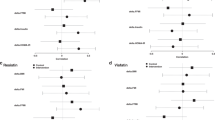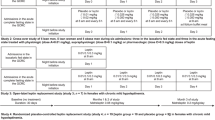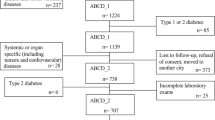Abstract
Leptin, the product of the ob gene1, is a hormone, produced by adipose cells, that inhibits food intake2–5 and increases energy expenditure2,3 in rodents. In humans, plasma leptin concentrations correlate closely with the size of the adipose tissue depot; however, there is considerable variation in plasma leptin concentrations at any given degree of fatness6,7. To investigate whether individuals prone to weight gain are hypoleptinemic, we measured fasting plasma leptin concentrations in two groups of weight-matched nondiabetic Pima Indians followed for approximately 3 years, 19 of whom subsequently gained weight and 17 of whom maintained their weight. After we adjusted for initial percent body fat, mean plasma leptin concentration was lower in those who gained weight than in those whose weight was stable. These data indicate that relatively low plasma leptin concentrations may play a role in the development of obesity in Pima Indians, a population prone to obesity.
This is a preview of subscription content, access via your institution
Access options
Subscribe to this journal
Receive 12 print issues and online access
$209.00 per year
only $17.42 per issue
Buy this article
- Purchase on Springer Link
- Instant access to full article PDF
Prices may be subject to local taxes which are calculated during checkout
Similar content being viewed by others
References
Zhang, Y. et al. Positional cloning of the mouse obese gene and its human homologue. Nature 372, 425–432 (1994).
Halaas, J.L. et al. Weight-reducing effects of the plasma protein encoded by the obese gene. Science 269, 543–546 (1995).
Pelleymounter, M.A. et al. Effects of the obese gene product on body weight regulation in ob/ob mice. Science 269, 540–543 (1995).
Campfield, L.A., Smith, F.J., Guisez, Y., Devos, R. & Burn, P. Recombinant mouse ob protein: Evidence for a peripheral signal linking adiposity and central neural networks. Science 269, 546–549 (1995).
Schwartz, M.W. et al. Specificity of leptin action on elevated blood glucose levels and hypothalamic neuropeptide Y gene expression in ob/ob mice. Diabetes 45, 531–535 (1996).
Maffei, M. et al. Leptin levels in human and rodent: Measurement of plasma leptin and ob RNA in obese and weight-reduced subjects. Nature Med. 1, 1155–1161 (1995).
Considine, R.V. et al. Serum immunoreactive-leptin concentrations in normal-weight and obese humans. N. Engl. J. Med. 334, 292–295 (1996).
Coleman, D.L. Obese and diabetes: Two mutant genes causing diabetes-obesity syndromes in mice. Diabetologia 14, 141–148 (1978).
Tartaglia, L.A. et al. Identification and expression cloning of a leptin receptor, OB-R. Cell 85, 1265–1271 (1995).
Lee, G.-H. et al. Abnormal splicing of the leptin receptor in diabetic mice. Nature 379, 632–635 (1996).
Schwartz, M.W., Boyko, E.J., Kahn, S.E., Ravussin, E. & Bogardus, C. Reduced insulin secretion: An independent predictor of body weight gain. J. Clin. Endocrinol. Metab. 80, 1571–1576 (1995).
Swinburn, B.A. et al. Insulin resistance associated with lower rates of weight gain in Pima Indians. J. Clin. Invest. 88, 168–173 (1991).
Ravussin, E. et al. Reduced rate of energy expenditure as a risk factor for body-weight gain. N. Engl. J. Med. 318, 467–472 (1988).
Maffei, M. et al. The human obese gene: Isolation, characterization, identification of a DNA polymorphism and mutation screening in obese/diabetic subjects. Diabetes 45, 679–682 (1996).
Considine, R.V. et al. Evidence against either a premature stop codon or the absence of obese gene mRNA in human obesity. J. Clin. Invest. 95, 2986–2988 (1995).
Norman, R.A. et al. Absence of linkage of obesity and energy metabolism to markers flanking homologues of rodent obesity genes in Pima Indians. Diabetes 45, 1229–1232 (1996).
Stirling, B. et al. Identification of microsatellite markers near the human OB gene and linkage studies in NIDDM-affected sib pairs. Diabetes 44, 999–1001 (1995).
Reed, D.R. et al. Extreme obesity may be linked to markers flanking the human OB gene. Diabetes 45, 691–694 (1996).
Clement, K. et al. Indication of linkage of the human OB gene region with extreme obesity. Diabetes 45, 687–690 (1996).
Saladin, R. et al. Transient increase in obese gene expression after food intake or insulin administration. Nature 377, 527–529 (1995).
Kolaczynski, J.W. et al. Acute and chronic effect of insulin on leptin production in humans: Studies in vivo and in vitro. Diabetes 45, 699–701 (1996).
Stephens, T.W. et al. The role of neuropeptide Y in the antiobesity action of the obese gene product. Nature 377, 530–532 (1995).
Schwartz, M.W., Peskind, E., Raskind, M., Boyko, E.J. & Porte, D., Cerebrospinal fluid leptin levels: Relationship to plasma levels and to adiposity in humans. Nature Med. 2, 589–592 (1996).
Collins, S. et al. Leptin stimulates sympathetic outflow to brown adipose tissue. Nature 380, 677 (1996).
Spraul, M. et al. Reduced sympathetic nervous activity: A potential mechanism predisposing to body weight gain. J. Clin. Invest. 92, 1730–1735 (1993).
Neel, J.V. Diabetes mellitus: A “thrifty” genotype rendered detrimental by “progress”. Am. J. Hum. Genet. 14, 353–362 (1962).
Ahima, R.S. et al. Role of leptin in the neuroendocrine response to fasting. Nature 382, 250–252 (1996).
Lillioja, S. et al. Insulin resistance and insulin secretory dysfunction as precursors of non-insulin-dependent diabetes mellitus. N. Engl. J. Med. 329, 1988–1992 (1993).
Author information
Authors and Affiliations
Rights and permissions
About this article
Cite this article
Ravussin, E., Pratley, R., Maffei, M. et al. Relatively low plasma leptin concentrations precede weight gain in Pima Indians. Nat Med 3, 238–240 (1997). https://doi.org/10.1038/nm0297-238
Received:
Accepted:
Issue Date:
DOI: https://doi.org/10.1038/nm0297-238
This article is cited by
-
Leptin, the brain and energy homeostasis: From an apparently simple to a highly complex neuronal system
Reviews in Endocrine and Metabolic Disorders (2022)
-
A fresh look to the phenotype in mono-allelic likely pathogenic variants of the leptin and the leptin receptor gene
Molecular and Cellular Pediatrics (2021)
-
Metabolic Factors Determining the Susceptibility to Weight Gain: Current Evidence
Current Obesity Reports (2020)
-
Role of Glucagon-Like Peptide-1 in Appetite Regulation in Patients with Morbid Obesity and Leptin Resistance
International Journal of Peptide Research and Therapeutics (2020)
-
Leptin and the endocrine control of energy balance
Nature Metabolism (2019)



